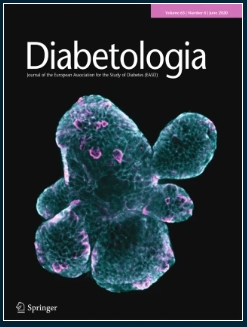Effect of acute exercise and exercise training on the ability of insulin to clear branched-chain amino acids from plasma in obesity and type 2 diabetes.
IF 8.4
1区 医学
Q1 ENDOCRINOLOGY & METABOLISM
引用次数: 0
Abstract
AIMS/HYPOTHESIS Insulin resistance in obesity and type 2 diabetes is associated with elevated plasma branched-chain amino acid (BCAA) levels. Here, we examined whether the ability of insulin to clear plasma BCAAs and any influence of acute exercise or exercise training on this response are intact in obesity and type 2 diabetes. METHODS In four case-control studies of participants with type 2 diabetes matched to glucose-tolerant individuals with obesity and lean individuals, who underwent hyperinsulinaemic-euglycaemic clamps, we examined the effect of insulin on plasma BCAAs (studies I-IV), with or without prior acute exercise (60 min, 70% V ˙ O 2max ) (study II), and before and after 10 weeks of endurance exercise training (study III) or 8 weeks of high-intensity interval training (study IV). RESULTS Insulin sensitivity was reduced in individuals with type 2 diabetes compared with individuals with obesity (study I-IV) and lean individuals (studies I and IV), and in individuals with obesity vs lean individuals (study I) (all p<0.05). Exercise training (studies III and IV) increased insulin sensitivity in all groups (all p<0.01). Plasma BCAAs were elevated in individuals with type 2 diabetes compared with individuals with obesity (studies I, III and IV) and lean individuals (studies I and IV) (all p<0.05). The ability of insulin to reduce plasma BCAAs was significantly attenuated in participants with type 2 diabetes compared with both lean individuals (studies I and IV) and individuals with obesity (studies I, II and IV) (all p<0.05). Acute exercise slightly reduced plasma BCAAs in both individuals with type 2 diabetes and individuals with obesity but did not potentiate insulin's ability to reduce plasma BCAAs (study II). Exercise training had no impact on fasting BCAAs and did not affect insulin's ability to reduce plasma BCAAs in any group (studies III and IV) or rescue the attenuated insulin suppression of plasma BCAAs in participants with type 2 diabetes. CONCLUSIONS/INTERPRETATION Our results demonstrate that insulin's ability to suppress plasma BCAAs is impaired in type 2 diabetes but is intact in individuals with obesity. Although acute exercise reduces fasting BCAA levels, neither acute exercise nor exercise training affects insulin's ability to suppress plasma BCAAs in glucose-tolerant individuals with or without obesity or in individuals with type 2 diabetes.急性运动和运动训练对肥胖症和2型糖尿病患者血浆中胰岛素清除支链氨基酸能力的影响。
目的/假设肥胖和2型糖尿病患者的胰岛素抵抗与血浆支链氨基酸(BCAA)水平升高有关。在这里,我们研究了胰岛素清除血浆支链氨基酸的能力,以及急性运动或运动训练对这种反应的影响是否在肥胖和2型糖尿病中完好无损。方法:在4项病例对照研究中,我们检测了胰岛素对血浆BCAAs的影响(研究I-IV),包括有或没有急性运动(60分钟,70% V˙o2max)(研究II),以及在10周耐力运动训练(研究III)或8周高强度间歇训练(研究IV)之前和之后。结果2型糖尿病患者的胰岛素敏感性与肥胖患者(研究I-IV)、瘦弱患者(研究I和研究IV)、肥胖患者与瘦弱患者(研究I)相比均降低(p<0.05)。运动训练(研究III和IV)增加了所有组的胰岛素敏感性(均p<0.01)。与肥胖(研究I、III和IV)和瘦弱(研究I和IV)患者相比,2型糖尿病患者血浆BCAAs升高(均p<0.05)。胰岛素降低血浆支链氨基酸的能力在2型糖尿病患者中与瘦个体(研究I和IV)和肥胖个体(研究I、II和IV)相比显著减弱(均p<0.05)。急性运动能轻微降低2型糖尿病患者和肥胖患者血浆BCAAs,但不能增强胰岛素降低血浆BCAAs的能力(研究II)。在任何一组(研究III和IV)中,运动训练对空腹BCAAs没有影响,也不影响胰岛素降低血浆BCAAs的能力,也不影响2型糖尿病患者血浆BCAAs胰岛素抑制的减弱。结论/解释:我们的研究结果表明,胰岛素抑制血浆支链氨基酸的能力在2型糖尿病患者中受损,但在肥胖患者中完好无损。尽管急性运动可以降低空腹BCAA水平,但无论是急性运动还是运动训练都不会影响胰岛素抑制糖耐受性个体(不论有无肥胖)或2型糖尿病患者血浆BCAA的能力。
本文章由计算机程序翻译,如有差异,请以英文原文为准。
求助全文
约1分钟内获得全文
求助全文
来源期刊

Diabetologia
医学-内分泌学与代谢
CiteScore
18.10
自引率
2.40%
发文量
193
审稿时长
1 months
期刊介绍:
Diabetologia, the authoritative journal dedicated to diabetes research, holds high visibility through society membership, libraries, and social media. As the official journal of the European Association for the Study of Diabetes, it is ranked in the top quartile of the 2019 JCR Impact Factors in the Endocrinology & Metabolism category. The journal boasts dedicated and expert editorial teams committed to supporting authors throughout the peer review process.
 求助内容:
求助内容: 应助结果提醒方式:
应助结果提醒方式:


